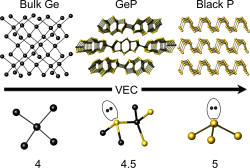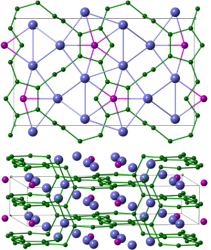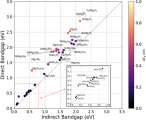Complex Frameworks
Thermoelectric materials capable of converting heat into power and vise versa can be used for a wide range of applications in freon-free refrigerators, waste heat converters, and direct solar thermal energy converters.
A unique class of host-guest compounds, Zintl clathrates exhibit Phonon Glass - Electron Crystal behavior and are considered promising TE materials. This research is supported by DOE BES.

Electro-Catalysis
Hydrogen has been proposed to be a clean and carbon-neutral next-generation energy carrier. Compared with curretnyl used steam reforming, water electrolysis represents a cleaner and more sustainable approach to hydrogen generation, but is underdeveloped. To deploy electrolyzers on a large scale and to make the electrolyzed hydrogen fuel economically competitive, it is important to develop nexpensive, earth-abundant electrocatalysts to promote the hydrogen evolution reaction (HER). We are working on transition metal phosphide, silicide, and boride catalysts. This research is supported by NSF CHEM CCAT program.

Tetrel-Pnictides
Binary tetrel-pnicitdes are layered v-d-W materials with exciting properties. Unlike phosphorene and realted materials, silicon- and germanium-pnictides are stable in acidic solutions which open possibilities for flux growth of large crystals using molten metals. Ternary metal tetrel-pnictides exhibit fascinating diversity of sructural motifs and plethora of properties. Polymorphism induced by preferential chemical bonding, ionic conductivity, and non-centrosymmetric semiconductors with non-linear optical properties are examples of areas we are interested in.

Synthetic Chalcogenides
Hybrid Fe-chalcogenide materials are a suitable platform to develop novel magnetic materials via understanding the structure-properties relationships. This project is devoted to (i) enhancing the solvothermal synthetic capabilities by developing novel synthetic techniques, and (ii) the sustainable synthesis of metastable functional materials. We expect that the developed synthesis methods will stabilize metastable functional materials with unprecedented composition, structural fragments, and properties which are not attainable by traditional high-temperature solid state syntheses. This research is supported by NSF DMR SSMC program.

AlterMagnetics

Solid ion conductors

Phosphide PVs
